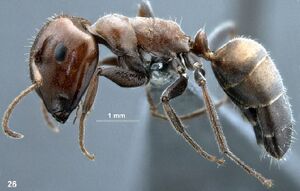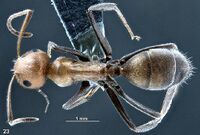Camponotus concurrens
| Camponotus concurrens | |
|---|---|

| |
| Scientific classification | |
| Kingdom: | Animalia |
| Phylum: | Arthropoda |
| Class: | Insecta |
| Order: | Hymenoptera |
| Family: | Formicidae |
| Subfamily: | Formicinae |
| Tribe: | Camponotini |
| Genus: | Camponotus |
| Subgenus: | Myrmamblys |
| Species group: | inquilinus |
| Species: | C. concurrens |
| Binomial name | |
| Camponotus concurrens Zettel & Laciny, 2018 | |
This species was found using the same foraging trails as a species of Colobopsis.
Identification
Zettel et al. (2018) - Minor worker: Trunk chiefly yellowish or pale orange; distal segments of antenna and parts of gaster brownish infuscated. Vertex highly domed. Clypeus at base broadly and shallowly emarginated and with a short, deep median impression; anterior margin straight. Flagellum slender. Mesosoma with reduced sculpture, shiny. Pronotum with short standing setae. Dorsal outline of pronotum strongly convex, of mesonotum and propodeum almost straight. – Major worker: Colour similar as in minor, head slightly darker. Head squared, shiny, with coarse puncturation; microsculpture evanescent except for area between high frontal carinae and eye. Eyes small. Clypeus with concave basal margin, a pair of large setiferous punctures near base, and a large shallowly depressed area apically. Reticulated sculpture of mesosoma more distinct than in minor, reduced only on pronotum. Petiole and gaster reticulated as in minor. Petiolar node more slender than in minor.
The minor of C. concurrens can be easily recognized by colour and the shiny, strongly convex pronotum. The major has a similar colour, but appears very different by a very shiny head (matt in minor), a reticulated microstructure of the mesosoma (except pronotum) and a moderately convex pronotum. Both castes can be distinguished from most other species (except Camponotus syaukanii) by short pronotal setae. These two species are very similar in structures and sculpture, although very different in colour, with C. syaukanii having a strongly infuscated mesosoma and petiole, and black gaster. Two clear differences are found in minor workers: Firstly, in C. concurrens, the anterior clypeal margin is straight, whereas in C. syaukanii it is distinctly protruded in the middle. Secondly, the strongly convex, “humped” pronotum of C. concurrens is evenly and moderately convex in C. syaukanii.
Specimens of C. concurrens from the Asian mainland differ from the type series from Borneo by a ground colour that is rather orange than yellowish, darker and slightly stouter funicular segments of antenna, and by a slightly lower, more stocky petiolar node. We consider these variations as intraspecific.
Keys including this Species
Distribution
Latitudinal Distribution Pattern
Latitudinal Range: 3.32466° to 3.32466°.
| North Temperate |
North Subtropical |
Tropical | South Subtropical |
South Temperate |
- Source: AntMaps
Distribution based on Regional Taxon Lists
Indo-Australian Region: Borneo, Brunei Darussalam (type locality), Malaysia.
Oriental Region: Thailand.
Distribution based on AntMaps
Distribution based on AntWeb specimens
Check data from AntWeb
Countries Occupied
| Number of countries occupied by this species based on AntWiki Regional Taxon Lists. In general, fewer countries occupied indicates a narrower range, while more countries indicates a more widespread species. |

|
Estimated Abundance
| Relative abundance based on number of AntMaps records per species (this species within the purple bar). Fewer records (to the left) indicates a less abundant/encountered species while more records (to the right) indicates more abundant/encountered species. |

|
Biology
Castes
Worker
Major
  
| |
| . | |
Queen
  
| |
| . | |
Nomenclature
The following information is derived from Barry Bolton's Online Catalogue of the Ants of the World.
- concurrens. Camponotus (Myrmamblys) concurrens Zettel & Laciny, in Zettel, Balàka, et al. 2018: 141, figs. 22-31 (s.w.q.) BORNEO (Brunei), THAILAND, WEST MALAYSIA.
- Type-material: holotype minor worker, 6 paratype major workers, 9 paratype minor workers, 2 paratype queens.
- Type-locality: holotype Brunei: Temburong, Kuala Belalong Field Studies Centre, 4°33’N, 115°09’E, 60 m., 6.iv.2005, KB05-36 (D.W. Davidson); paratypes: 3 major workers, 2 queens with same data, 2 major workers, 2 minor workers Thailand: Chanthaburi Prov., Pheao N.P., Troknong Waterfall, 24.xi.2003, TH03-WJT502 (W. Jaitrong), 1 minor worker Thailand: Loei Prov., Phu Luang W.S., 13.v.2007, SH07-TH (S. Hasin), 1 minor worker Thailand: Khao Yai N.P., 900-1000 m., 20.v.2000 (Sk. Yamane), 1 major worker, 1 minor worker Malaysia: Selangor, Kuala Lumpur, Ulu Gombak FSC, 240-270 m., 21.i.1987, SEA-0742 (W.H.O. Dorow).
- Type-depositories: NHMW (holotype); NHMW, TNHM, WDPC (paratypes).
- Status as species: Khachonpisitsak, et al. 2020: 41.
- Distribution: Brunei, Malaysia (Peninsula), Thailand.
Unless otherwise noted the text for the remainder of this section is reported from the publication that includes the original description.
Description
Worker
Minor
Holotype: HW 1.28; HL 1.47; SL 1.50; SW 0.16; EL 0.40; ML 1.96; HaL 0.18; FeL 1.79; CI 87; SI 117; EI 32; FeI 140. Ward’s Indices: ASM/HWex 0.33; ASM/CLW 0.64; CLW/CLL 1.48. Paratypes (n = 5): HW 1.20–1.35; HL 1.37–1.54; SL 1.35–1.45; SW 0.13–0.15; EL 0.36–0.42; ML 1.70–2.15; HaL 0.21–0.26; FeL 1.60–1.86; CI 82–87; SI 107–116; EI 30–35; FeI 136–147. Ward’s Indices: ASM/HWex 0.29–0.31; ASM/CLW 0.59–0.63; CLW/CLL 1.30–1.51.
Structures: Head elongated, dorsally finely reticulated and matt; ventrally with reduced microsculpture and shiny. Lateral outline of eye and head contiguous. Vertex strongly domed. Shiny midline of frons very fine. Clypeus with broad, but shallow emargination of basal margin; distal margin not protruded in middle; median impression reduced, very short, although deep. Mandible finely punctured, with five teeth. Mesosoma moderately slender and low, shiny; reticulated microstructure reduced, especially on pronotum; dorsal outline of pronotum strongly, posterior slope of propodeum weakly convex; indention between pro- and mesonotum and mesonotum and propodeum indistinct. Petiole with stocky, comparatively low node, its anterior and posterior face almost parallel, apex obliquely truncated. Gaster tergites with dense reticulation, also on the very narrow, weakly delimited, translucent marginal stripes.
Pilosity: Whitish standing setae on dorsum comparatively short, moderately long on vertex (only few), propodeum, petiole, and apex of gaster. Subdecumbent pubescence short, thin, inconspicuous; very sparse on head.
Colour: Head, mesosoma, and petiole pale yellowish or orange, tending to light brown. Gaster brownish infuscated, ventrally stronger than dorsally; tergites 1–2 light yellowish brown. Antennae yellow, distally brownish. Legs proximally dark brown, distally paler, tending to yellow.
Major
Paratypes (n = 6): HW 1.67–1.91; HL 1.98–2.27; SL 1.17–1.35; SW 0.15–0.21; EL 0.46–0.50; ML 2.22–2.67; HaL 0.13–0.21; FeL 1.47–1.70; CI 84–88; SI 67–73; EI 26–30; FeI 87–95.
Structures: Head squared, clearly longer than wide. Eyes small, laterally not reaching sides of head. Ocellar scars absent or present. Frontal carinae prominent, curved. Dorsal surface with strong, widely spaced punctures; interspaces with reduced, hardly visible microsculpture, except area between high frontal carinae and eye clearly reticulated. Clypeus moderately narrowed, about 1.5 times as long as wide, with relatively fine, widely spaced punctures and with a pair of deep setiferous grooves near basal corners (a few larger punctures may occur at sides); basal margin medially with wide and shallow emargination; no median carina; anterior margin strongly protruded, but not surpassing genae; a large distal area shallowly depressed. Mandibles with fine, widely spaced punctures only. Mesosoma with finely reticulated microsculpture and matt, except for the shiny pronotum. Dorsal outline of pronotum moderately convex, dorsal indentions behind pronotum and mesonotum weak. Node of petiole narrow, apex narrowly rounded. Gaster similar as in minor.
Pilosity: Standing setae similar as in minor; with a pair of short setae in basal corners of clypeus. Short pubescence absent from head.
Colour: Similar as in minor, but slightly darker on head and posterior parts of tergites 1 and 2. Ventral parts of mesosoma variably infuscated.
Queen
Paratypes (n = 2): HW 1.51–1.52; HL 1.70–1.72; SL 1.33–1.36; SW 0.17–0.18; EL 0.52–0.53; ML 2.93; HaL 0.17–0.21; FeL 1.92; OcW 0.11; FWL 8.54–8.67; CI 88–90; SI 88–89; EI 35; FeI 126–127.
Structures: Intermediate between minor and major in many characters. Head roundish. Eyes large, slightly surpassing outline of head. Ocelli present. Sculpture of head similar as in major, but punctures generally larger and denser. Posterior part of head (from middle of frons to vertex) with variable large reticulated area (large in the illustrated specimen). Clypeus with emarginated base and medially protruded anterior margin, without distal depressed area. Entire mesosoma, including pronotum with reticulated microsculpture, slightly shiny. Petiole similar as in major, the node slightly lower. Gaster large, but otherwise similar as in worker castes, the translucent margins slightly wider.
Pilosity: As in major worker, including absence of short pubescence on head.
Colour: As in major worker. Wings with strong grayish-yellow tinge. Veins yellow.
Male
One male collected with the type series is possibly conspecific, but not described because it differs considerably in colour.
Type Material
- Holotype (minor worker #1787; NHMW) from Brunei, Temburong, Kuala Belalong Field Studies Centre, N 04°33', E 115°09', 60 m a.s.l., 6.IV.1994, leg. D.W. Davidson, #KB05-36.
- Paratypes (NHMW, THNMH, CDF): 3 major workers (#1788–1790) and 2 alate gynes (#1791, 1792), same nest series as holotype; 2 minor workers (#1656, 1657), 2 major workers (#1654, 1655), Thailand, Chanthaburi Province, Pheao N.P., Troknong Waterfall, tropical rainforest, 24.XI.2003, leg. W. Jaitrong, #TH03-WJT502; 1 minor worker (#1658), Thailand, Loei Province, Phu Luang W.S., 13.V.2007, leg. S. Hasin, #SH07-TH; 1 minor worker, Thailand, Khao Yai N.P., 900–1000 m a.s.l., 20.V.2000, leg. Sk. Yamane; 1 minor worker (#1160), 1 major worker (#1161), Malaysia, Selangor, Kuala Lumpur, Ulu Gombak FSC, N 3.32466°, E 101.752717°, 240–270 m a.s.l., 21.I.1987, leg. W. H. O. Dorow, #SEA-0742.
Etymology
Participle of the Latin verb concurrere, meaning “running together”. The name refers to the supposed foraging of C. concurrens on undescribed Colobopsis cylindrica group ant-trails.
References
- Khachonpisitsak, S., Yamane, S., Sriwichai, P., Jaitrong, W. 2020. An updated checklist of the ants of Thailand (Hymenoptera, Formicidae). ZooKeys 998, 1–182 (doi:10.3897/zookeys.998.54902).
- Zettel, H., Balàka, P., Yamane, S., Laciny, A., Lim, L., Druzhinina, I.S. 2018. New mimetic ants from Southeast Asia – the Camponotus (Myrmamblys) inquilinus group (Hymenoptera: Formicidae: Camponotini). Zeitschrift der Arbeitsgemeinschaft Österreichischer Entomologen 70:125-174.
References based on Global Ant Biodiversity Informatics
- Zettel H., P. Balaka, S. Yamane, A. Laciny, L. Lim, and I. S. Druzhinina. 2018. New mimetic ants from Southeast Asia – the Camponotus (Myrmamblys) inquilinus group (Hymenoptera: Formicidae: Camponotini). Zeitschrift der Arbeitsgemeinschaft Osterreichischer Entomologen 70: 125-174.

